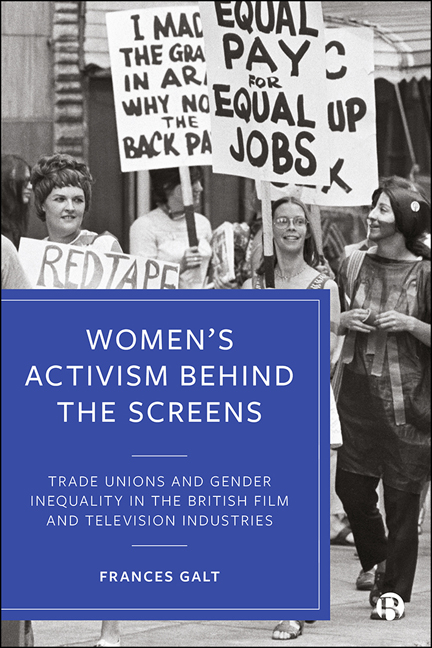 Women's Activism Behind the Screens
Women's Activism Behind the Screens 1 - Women and the ACT, 1933– 59
Published online by Cambridge University Press: 17 April 2021
Summary
A profoundly gendered union structure was institutionalized within the Association of Cine-Technicians from its establishment in 1933, which operated to prioritize men's interests and exclude the interests of women workers in its organizational practices and negotiated agreements. This had significant ramifications for the ACT and its successors, shaping their relationship with women workers from 1933 to the present day. There were three periods of institution building between 1933 and 1959 which defined and solidified the ACT's gendered union structure. During the establishment and formative years of the ACT in the 1930s the union focused on organizing male-dominated sections of the British film industry, particularly in the studios, and mobilized a gendered definition of skill to distinguish which grades should be represented by the union. Its focus on male-dominated sections of the film industry was intensified during the Second World War, as the ACT was appointed as the ‘official vetting body for war-time film technicians’ (ACTT, 1983: 21) and was established as a pre-entry closed shop by the end of the war. During the war, the ACT further acted to consolidate gender inequality in the union structure, as it responded to the influx of women workers through agreements and organizational practices which functioned to safeguard men's wages and conditions. Finally, post-war debates and inter-union negotiations around the remit of the ACT and the grades it represented within the film industry consolidated the gendered union structure. This chapter illuminates the process of unionization which institutionalized gender inequality within the ACT's union structure. Between 1933 and 1959, there was little challenge to the gendered union structure and women remained largely invisible in the ACT. However, this chapter seeks to make visible women's union participation and highlight sites of protofeminism in this period.
The establishment and formative years of the ACT
Existing scholarship on trade unionism in the film and television industries has primarily provided a historical analysis of the establishment and formative years of the ACT during the 1930s (Chanan, 1976; ACTT, 1983; Jones, 1987; Low, 1997; Reid, 2008; Hochscherf, 2011). Furthermore, articles which retold the history of the ACT's establishment were featured in the union journal, The Cine-Technician, in 1938 and 1954. Existing scholarship has concentrated on two topics: the incentives for unionization in the British film industry and the process of unionization during the 1930s.
- Type
- Chapter
- Information
- Women's Activism Behind the ScreensTrade Unions and Gender Inequality in the British Film and Television Industries, pp. 27 - 62Publisher: Bristol University PressPrint publication year: 2020


